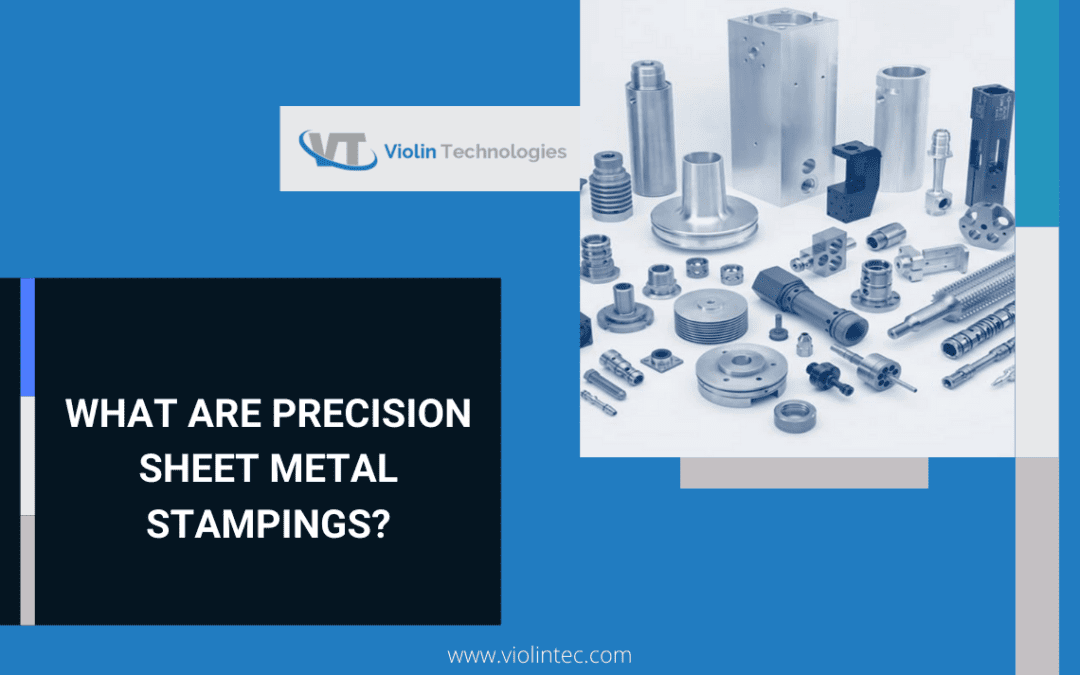What is Precision Sheet Metal Stamping Process?
Precision sheet metal stamping uses sheet metal in blank or coil form, diet set, and stamping press to transform them into desired custom shapes. In the precision sheet metal stamping process, sheet metal is placed in a stamping machine, once the feed reaches forming station, a die set or tool installed inside the stamping machine punches the material to get the desired shape and size. The stamping press exerts the pressure on the workpiece which forces the material to conform to the shape of the tool or die set.

After sheet metal is converted into net shape by die set, the manufacturer runs it through various stages to get desired finished product. Die set is designed according to the shape of the desired product.
Stamping is done through various processes using progressive tooling and stage tools such as Blanking, Bending, Punching, Drawing, Embossing, Piercing, Curling, and so on. It can either be done in single stage motion or across multiple stages depending on the type of stamping presses and complexity of desired product along with some other factors such as the material used, thickness, dimensions, and the amount taken into consideration. These operations generally rely on automated equipment to ensure precise and accurate finished products.
Generally, micro or mini complex precision components such as terminal connectors are manufactured in large quantities using high-speed presses and progressive dies. On other hand, large components in small quantities are manufactured using heavy-duty presses with high tonnage capabilities and single-stage dies.
Advantages of Precision sheet metal stamping:
There are a few things you need to consider while determining whether the precision sheet metal stamping is right for your project or not.
In addition to high precision and accuracy, there are several more advantages of the precision sheet stamping process over other manufacturing processes. We have listed a few of them right below:
- Low Production Costs: The precision sheet metal stamping process improves the cost efficiency by mitigating the need for manual labor, thus reducing labor costs. A low error rate during production means less material utilization and waste during the manufacturing process, thus reducing manufacturing costs.
- Great Product Quality and Accuracy: Precision sheet metal stamping is a highly accurate process due to the low error rate during production, which significantly reduces the percentage of faulty or flawed products manufactured and reaching the hands of the customer. It enables the production of precise parts with a high degree of accuracy.
- Detailed and Highly Complex Projects: The precision metal stamping process helps in managing complex projects requiring microstamping and detailed work to produce high-quality and precisely finished components.
- Flexibility: Precision metal stamping is highly versatile in nature. Light and durable metal can be transformed into miniature sizes and all kinds of complex shapes while adhering to high tolerance specifications. It opens up a completely new world of design possibilities within tight tolerances. It is a highly customizable process to produce complex and highly specialized parts.
- Speed: Using this process, Contract Manufacturers can produce precise components, which saves both money and time.
- Automation: Contract Manufacturers can produce large volumes of the same design components without any need for manual intervention
Considerations while Using Precision Sheet Metal Stamping Techniques:
- Precision of Prototype/ Design: It is important to come up with highly accurate designs and prototypes with accurate specifications to avoid expensive errors. Defects, errors, and imperfections can affect the overall strength and integrity of components during production as well as their functionality during operations.
- Materials Used: Different materials react differently under high pressure and temperature. For example, Metals react differently from Plastics when heated and compressed. Therefore, it becomes essential to understand specific characteristics and behaviors of materials before using them for manufacturing components using the precision sheet metal stamping process.
- Volume: Quantity matters a lot when it comes to precision sheet metal stamping. It is most beneficial and cost-efficient for high-volume production. However, in the case of low volume production cost of progressive die becomes a limitation.
In conclusion
Precision Sheet Metal Stamping is a fast, reliable, flexible and cost-efficient technique for the production of precision metal components for various industries. However, it is vital to consider the above factors while determining whether the precision sheet metal stamping is right for you or not. It becomes more economical as order quantities and product volumes increases.
Read more interesting articles in our blog section “How to Choose the Best Wire Harness Manufacturing Company in India?” and “5 Things To Keep In Mind When Choosing Your Best Contract Manufacturing Partner” and share your valuable feedback.

